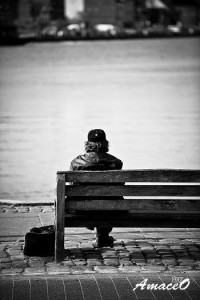
HAVANA, Cuba , September 9, 2012, David Canela Piña / www.cubanet.org.- Last Friday the civic project Estado de Sats put on, at its usual site, a photographic exhibition by Cuban artist Alberto Maceo, who currently resides in Flensburg, a small German town on the border with Denmark. The exhibition, entitled From Havana to Here, included thirteen portraits of ordinary people of the streets of Germany, and also to a Cuban woman looking to the horizon from the Malecon. The artist was not present at the exhibition.
Cubans have a cultural similarity with the German population: in both communities the people daydream looking out to the sea, breathing the sea air. Perhaps it was this reminiscence that inspired Maceo to search faces for something Cuban: a distant yearning, an introspective silence. The sharpest eye might discover that they are lower class people, but possessing of a certain dignity.
However, the attributes and attitudes revealed in the composition of these figures are not enough to evoke a defined psychological and social profile. The majority neither seduce nor move one. There is a lack of substance, an infinite projection. Some images look like studies: an expression, lacking temperament, delighting in the vanity of its pose.

Very few manage to be a vehicle that leads to another universe: the Cuban woman, wrapped in a cloud of mystery, as if watching from the tower of a fortress; the young guitarist who seems to imagine or remember the verses of a song; and a man sitting on a bench, watching a fjord in the gloom. In the other images, it is difficult to guess at a story, an atmosphere, a conflict.
The quality of the photos is undeniable, but they lack character, uniqueness, and the prism of suggestion. It is true that not all photos can be iconic, like that of Sharbat Gula, the Afghan girl who was photographed in 1984 for National Geographic, but they should aspire to those reflections of the soul, and life experience.
Estado de Sats, builder of bridges
As Antonio Rodiles once said, the main objective of Estado de SATS is to create a public space within the Island. If voices that are pro-government (at least in appearance) are excluded or reject the invitation, either out of fear, convenience or laziness, it’s a personal matter for each person. But the space is open to all arguments, tendencies and attitudes, as long as they are defended with respect and rationality.

The second objective has been to build bridges of recognition and collaboration within civil society, some of whose members have been marginalized for their ideology, and for not worshiping a state that presents itself as the supreme idol. These, from their experiences and convictions (and I must say also , from poverty and homelessness), have decided to reclaim their dignity, and pay the price for their independence.
Perhaps the objective can be summarized as an opening new horizons, and between them, leading to healing through beauty, and refining the sensitivity of many people who have become accustomed to marginality, marginalization, beatings and jail cells. Estado de Sats is a path through the weeds, leading to democracy and reconciliation.
About the author
![]()
David Canela Piña. He was born on April 27, 1981 in Havana. He attended Fabricio Ojeda primary school and Otto Barroso secondary, both in the municipality of Habana del Este. He earned a scholarship to the V. I. Lenin Institute of Exact Sciences High School, graduating in 1999. In 2006 he graduated with a degree in Literature from the University of Havana, with a thesis on the poetic worldview of the Cuban writer Raul Hernandez Novás . He has worked as an editor, professor of grammar, literary scholar , and now as a digital media journalist. For seven years he lived in Diez de Octubre; he now lives in the municipality of Playa.
From Cubanet
9 September 2013
